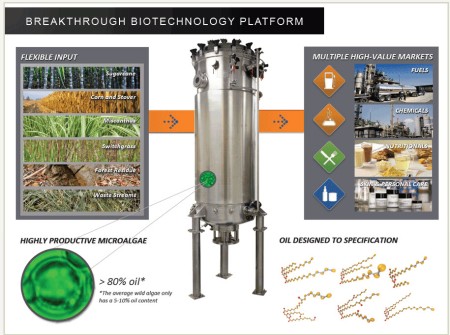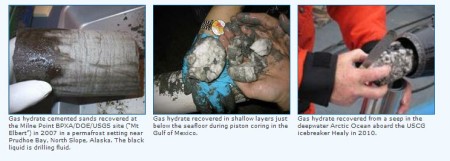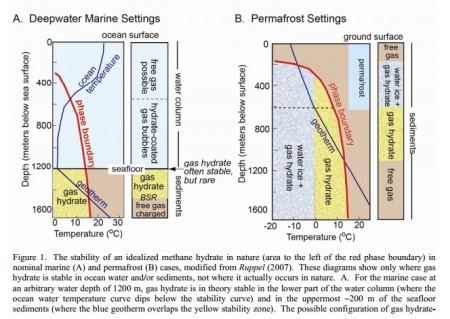If it’s all about Unconventionals today, what’s tomorrow’s story?
So the fracking revolution is here. This relatively new technology has led to a surge in US onshore production from plays such as the Bakken, Eagle Ford, and Marcellus. It’s a technological success story. Of course, many are taking this success as proof of the cornucopian thesis – that we can simply never run out of oil and that hydrocarbons are limitless. But the new Unconventional technologies don’t remove resource constraints, they just kick the can down the road. Arguably their success today makes the future challenge greater.
In the long term, and only a fool would predict when, Unconventional hydrocarbons will also reach a production limit. Drilling will eventually pause, and production will plummet. We will need something else, something new. What technology might be next? What’s the fracking technology of the future?
There’s a lot of research going on. It’s early days, and progress is slow, but it could be pretty exciting.
Bugs, Bacteria, and Ice…
Exxon is not exactly known for its crazy kookiness and is about as far from Google’s culture as you can get, yet it has been throwing money into some pretty “out-there” futuristic ideas for a while now. Exxon’s investments highlight that even this Texan good-old-boy is sufficiently worried about the future of conventional oil production that they are not only willing to bet over $30 billion on their purchase of XTO’s shale gas business, but that when they think long term they’re willing to Think Big.
In the oil industry Exxon is considered The Man, in both the bad sense of establishment & greed, and the good sense of being very good at what they do and rarely getting a business decision wrong. They are the Borg. In the early part of the 21st century Exxon took a look at the world, and at our growing population & increasing energy needs, and concluded that alternative energy just couldn’t deliver the goods. To power the world we need a fuel that has high energy density and is transportable. Exxon couldn’t see an alternative to liquid fuels similar to those we use today. But how could you access more oil? What would power the world in 2050 and beyond? Surprisingly, their conclusion was the same as J. Craig Venter’s – we should grow it.
In July 2009 Exxon invested $600 million* in a venture with Synthetic Genomics Inc, a Venter company, to genetically engineer algae to produce commercially viable fuel.
(*This sounds like a lot of money, but Exxon’s $600 million investment should be contrasted with their $301.5 billion in revenue.)
It’s all very science fiction (in fact, it’s the broad basis for a recent book), and in their own way these technologies are just as futuristic as Google glass, but potentially a lot more important.
Algae grows fast. In fact an algal cell can double in size every 6-24 hours. Algae is also relatively high yielding. An acre of corn creates about 1,100 litres (250 gallons) of fuel. The goal of algae production is to produce something like 45,000 – 70,000 litres (10,000 – 15,000 gallons). And in contrast to ethanol mixes, the fuel algae create needs little processing, being chemically indistinguishable from its petroleum based diesel equivalent. Oh, and algae eats C02 like there’s no tomorrow. Yup, that’s right, Exxon invested in a way to turn C02 into oil with some trippy genetics.
And Exxon is not the only one. Bill Gates, Chevron, Shell, DARPA, the Wellcome Trust, the Carbon Trust, and Toyota are all invested in algal bio-fuels. There are projects all over the US.
Issues
But… there are some serious issues. Algae need a home and their natural in-situ energy density is actually very low compared to petroleum. After all, an Unconventional oilfield is just palaeo-algae, greatly compressed by burial beneath kilometers of rock and gently cooked over geologic time; processes that greatly increase energy density. A living algal oilfield would need thousands of acres of ponds or vats, piped C02, fresh water, and a connection to a refining system. And besides the fact that algae are alive, and thus have predators that would just love to munch their way through an outdoor pool of food (something you don’t have to worry about too much with petroleum), there may be some fundamental scientific and industrial issues between lab experimentation and commercially viable production.
One particular issue is the ferment wall. Scaling up from the lab to the industrial plant has proved challenging, and fermenting at the scale required for commercially competitive production (something greater than 500,000 litres) has taken longer than predicted.
In 2011 and 2012 a next-gen biofuels company, Amyris, attempted a linear scale-up to a 200,000 litre facility. Sometimes it worked, but often the enormous tanks simply frothed with the carcasses of exploded yeast cells. The current front-runner is Solazyme. Last year Solazyme announced that they had managed to complete initial fermentations in a 500,000 litre fermenter.
Solazyme are targeting 20,000 tonnes of oil in 2014 from their Iowa facility. That sounds great, right! Twenty thousand metric tonnes. Unfortunately, that’s about 150,000 barrels a year, or just 400 barrels a day. It’s equivalent to a very, very small oilfield, or a single average Unconventional Bakken well, which would have cost around $7-10 million to drill & frac. Solazyme has expansion plans to 100,000 tonnes, or around 2000 barrels a day but the technology won’t really be there until it can achieve 100 times this. Progress is progress though, and Solazyme released an algae-based fuel for sale in the Bay Area last year and have tested their fuels in aircraft and navy vessels.
Sapphire, a competitor, have followed a similar lead to Solazyme, and currently have a test facility near Columbus, New Mexio.

Algae farm in New Mexico
In contrast, progress at Synthetic Genomics Inc appears slower and more opaque, but it may be a case of the hare and the tortoise. The Venter firm is deconstructing the algal genome and rebuilding it from the bottom up. So far the Synthetic Genomics team has managed to alter the colour of the cell wall from dark green to light yellow, letting in more light to the chemical factories inside. To test scale they’ve built a 1 million litre, 42 ponds facility. Production starts soon.
Unfortunately, Exxon seem to have fallen out with Venter and have questioned the basic science, publicly stating that the technology is 25 years away, at least, and have removed the algal page from their corporate website. It’s hard to say, given the secrecy of Synthetic Genomics, if this apparent rift is significant.
How do you milk a bacterium?
Another genetic technique in the race for new fuels goes a step smaller – bacteria. Two studies published in April 2013 outlined ways to make genetically engineered E. coli bacteria produce a hydrocarbon molecule that mimics petroleum. Instead of having to extract the oil, the teams have effectively found a way to extract the oil by “milking it”. The technique uses a family of transport proteins typically known as ABC transporters. The good news is that algae have these too, and the technique may be applicable, enabling algae to continually produce and secrete biofuels indefinitely.
How Much?
Scale is a huge issue. Even after billions of dollars of investment the Welcome Trust is hoping to make just 70 billion litres by 2030. That’s just 6% of 2012’s diesel use. Many more advances will be needed for the technology to produce truly commercial, transformative, yields.
Which leads to another technology – Gas Hydrates
The Chikyu
Gas hydrates are everywhere. They can be found across the globe in water depths >500-600m and are regularly imaged on industry seismic sections. They are even found in arctic regions beneath permafrost.
Hydrates are a crystalline form of water and gas (generally methane, but can be ethane or C02) and at the molecular level consist of gas molecules caged by bucky-ball like water molecules. If an industrial way to extract this trapped gas can be found we are unlikely to run out for a very, very long time. There’s up to 4 million TCF out there, and the minimum estimate is over 4000 years US supply (by which time the world’s population will weigh more than the earth itself, based on current population growth trends…ahem.) But turning this trapped methane into an actual commercial resource is not going to be easy.
Gas hydrates are formed in cold temperatures/high pressures (to the left of the phase boundary in the temperature – depth graphs below). It’s important to realise that the vast bulk of the potential methane hydrate prize isn’t just sitting on the surface of the seafloor, but buried within shallow sediments. Producing it is incredibly difficult, but earlier this year the Japan Oil, Gas and Metals National Corp (JOGMEC), working closely with Canada, successfully extracted 120,000 cubic meters (~4 million cubic feet) of gas from a 6 day production test of methane hydrates offshore from Japan’s Atsumi and Shima peninsulas. The next test is due in 2014. This frontier science is incredibly expensive, but may be one of the first steps to unlock this long-term prize.
Conoco-Philips has also been working to produce arctic hydrates from beneath the permafrost.
The real issue
It’s hard to overstate the scale of the problem. We use an almost unbelievable amount of petroleum every day. Replacing this from a standing start with new fuels is a daunting task.
All of the new technologies described have real issues and are incredibly challenging, requiring long time-frames to develop. They are difficult, high tech, and require considerable financial and human resources to even begin to unlock, but we are up to the task if we plan ahead.
Unfortunately, our economy (and our psychology) is simply not set up to consider the long term.
Just take a look at our financial sector. Capitalism, or at least finance in its current form, is all about the next year, or the next quarter. Our psychology is similar, and we regularly heavily discount events in the future, showing a strong preference for right-now. This trend seems to be increasing. This would perhaps not be a problem if we didn’t live in a world where long term issues were threatening our way of life, but that’s where we’re are.
It might not seem like it, but the danger of future energy insecurity is actually increasing. Unconventionals are part of the issue. Not only does the great technological story and quotes about energy independence remove any feeling of risk, and thus strip funding away from alternatives, but as the world’s oil and gas production transfers from conventional to Unconventional oilfields the likely future decline rates increase. In fact, Unconventional oilfields decline ten times faster than conventional oilfields. So gravy today risks pain tomorrow. When the Unconventional oilfields finally tip over we will have very little warning.
The time for the science, the prep work, and investment to reduce the chance of energy shock is now. If you want to be ready in 20, 30,or 50 years to simply switch fuels, as we did from whale oil to rock oil, then we need to find a way to invest for the long term. If we do invest we can make the technology work. If we do not, then it’s just a lottery.







Pingback: Some kind of Planctron | Planctron
Pingback: » Algal Bio Fuels - Planctron